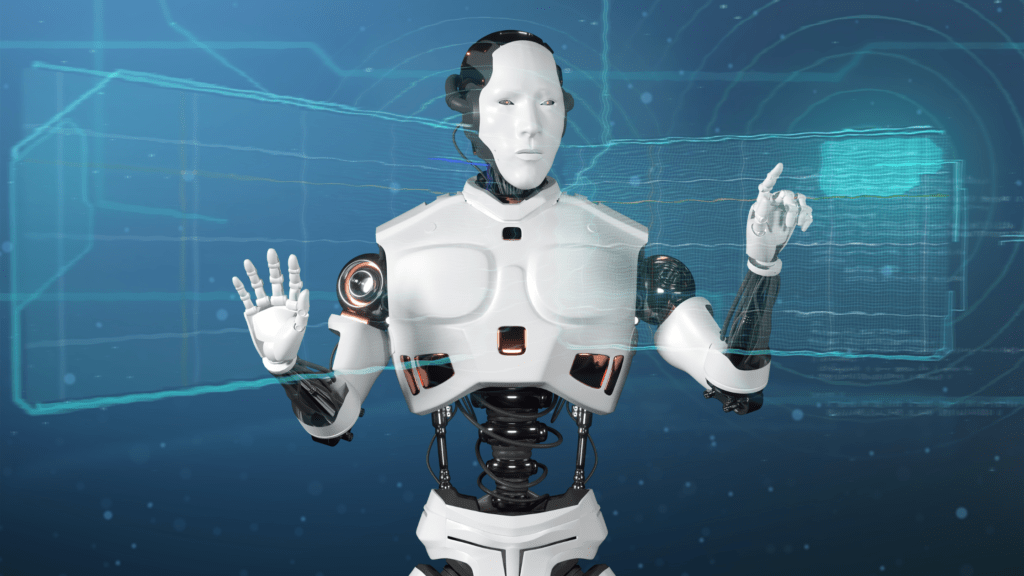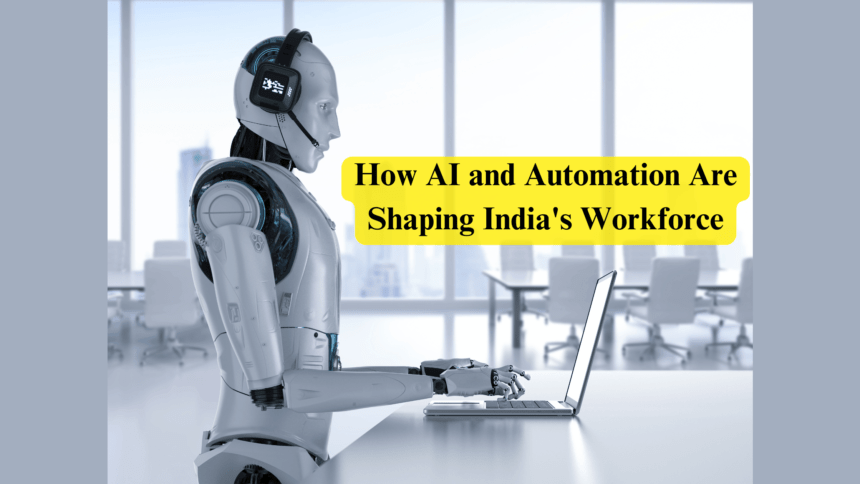Introduction
The Dawn of a New Era
We stand at the cusp of an extraordinary transformation. The integration of artificial intelligence (AI) and automation into the workplace is not just a forecast but an unfolding reality. This evolution is set to redefine the paradigms of employment, particularly in a diverse and dynamic economy like India.
The Indian Workforce at a Crossroads
The Indian workforce, vast and varied, is encountering unprecedented changes. These changes, driven by technology, are altering traditional job roles, creating new opportunities, and challenging existing norms. How India navigates this crossroads will significantly influence its economic future.
The Rise of AI and Automation

Defining AI and Automation
AI refers to the simulation of human intelligence in machines programmed to think and learn. Automation involves using technology to perform tasks with minimal human intervention. Together, they form a powerful duo reshaping industries globally.
Historical Perspective
The journey of AI and automation began decades ago, with early computers and automated machinery laying the groundwork. Over time, advancements in computing power and algorithmic sophistication have accelerated their development, making AI and automation more accessible and impactful than ever before.
Current Landscape in India
Present State of AI and Automation
India is rapidly adopting AI and automation across various sectors. From chatbots in customer service to automated assembly lines in manufacturing, the presence of these technologies is becoming ubiquitous. This adoption is driven by the need to improve efficiency, reduce costs, and stay competitive in a global market.
Government Policies and Initiatives
The Indian government has recognized the potential of AI and automation. Initiatives like the National AI Strategy and Digital India aim to foster innovation, promote digital literacy, and support AI-driven projects. These policies are crucial in positioning India as a global leader in AI.
Sectors Most Affected
Manufacturing
The manufacturing sector, a cornerstone of India’s economy, is witnessing a significant transformation. Automation in factories is streamlining production processes, enhancing quality control, and reducing human error. Robots and automated systems are becoming commonplace on factory floors.
Healthcare
AI is revolutionizing healthcare by improving diagnostics, personalizing treatments, and managing patient care more efficiently. AI-driven tools are assisting doctors in diagnosing diseases at earlier stages and developing customized treatment plans.
Retail
The retail sector is leveraging AI for predictive analytics, inventory management, and customer service. Automated checkout systems, personalized shopping experiences, and efficient supply chain management are transforming the retail landscape.
Education
In education, AI is enhancing personalized learning, automating administrative tasks, and providing valuable insights into student performance. Educational institutions are adopting AI tools to offer more engaging and effective learning experiences.
Positive Impacts on Employment
Creation of New Job Roles
AI and automation are not just about replacing jobs; they are also about creating new ones. Fields like AI development, data science, and machine learning engineering are booming, offering lucrative career opportunities.
Enhanced Productivity
By taking over repetitive and mundane tasks, AI and automation free up human workers to focus on more complex and creative endeavors. This shift can lead to significant productivity gains and job satisfaction.
Upskilling and Reskilling Opportunities
The evolving job landscape necessitates continuous learning. Upskilling and reskilling initiatives are crucial in preparing the workforce for new roles. Companies are investing in training programs to equip employees with the skills needed to thrive in an AI-driven world.
Challenges and Concerns
Job Displacement
One of the primary concerns is the displacement of jobs due to automation. While some jobs may become obsolete, others will emerge. The challenge lies in managing this transition smoothly and ensuring that workers are not left behind.
Skill Gap Issues
The rapid pace of technological advancement has created a skill gap. There is a growing need for workers with expertise in AI and related technologies. Addressing this gap requires a concerted effort from educational institutions, businesses, and policymakers.
Ethical Considerations
The deployment of AI raises ethical questions regarding privacy, bias, and accountability. It is essential to develop frameworks that ensure the responsible and fair use of AI technologies.
Case Studies
Successful AI Integration in Indian Companies
Several Indian companies have successfully integrated AI into their operations. For instance, Tata Consultancy Services (TCS) uses AI for predictive maintenance, while Reliance Jio leverages AI for customer service automation. These examples highlight the transformative potential of AI.
Stories of Transformation
AI has also transformed small businesses and startups. For example, a local e-commerce company used AI to optimize its supply chain, resulting in significant cost savings and improved customer satisfaction.
The Role of Education
Importance of STEM Education
A strong foundation in science, technology, engineering, and mathematics (STEM) is crucial for fostering a workforce capable of driving AI innovations. Encouraging STEM education from an early age can prepare students for future careers in AI.
Vocational Training and Its Relevance
Vocational training programs focused on AI and automation skills are becoming increasingly relevant. These programs offer practical, hands-on experience, making them an effective way to bridge the skill gap.
Government and Policy Interventions
Existing Policies
The Indian government has introduced several policies to support AI adoption. These include funding for AI research, tax incentives for tech startups, and initiatives to promote digital literacy.
Future Policy Directions
Going forward, policies should focus on creating an enabling environment for AI innovation, ensuring ethical AI use, and providing support for workers transitioning to new roles.
Future Skills and Competencies
Skills in Demand
The future job market will demand skills such as data analysis, machine learning, and AI programming. Additionally, knowledge of cloud computing, cybersecurity, and blockchain will be valuable.
Soft Skills vs. Technical Skills
While technical skills are essential, soft skills like critical thinking, creativity, and emotional intelligence will also be crucial. These skills will complement technical expertise and enable individuals to adapt to changing job roles.
The Gig Economy
Rise of Freelance and Contract Work
AI is contributing to the rise of the gig economy by enabling flexible work arrangements and on-demand services. Freelancers and contract workers can leverage AI tools to enhance their productivity and offer specialized services.
Impact of AI on the Gig Economy
AI platforms are matching freelancers with job opportunities more efficiently. However, this shift also raises questions about job security and benefits for gig workers.
Small and Medium Enterprises (SMEs)
AI Adoption in SMEs
SMEs are increasingly adopting AI to streamline operations, enhance customer experiences, and gain competitive advantages. AI tools are becoming more accessible and affordable, making it easier for SMEs to integrate them into their workflows.
Challenges Faced by SMEs
Despite the potential benefits, SMEs face challenges such as limited resources, lack of technical expertise, and resistance to change. Addressing these challenges requires targeted support and training programs.
Rural vs. Urban Divide
AI Impact in Rural Areas
AI has the potential to transform rural economies by improving agricultural productivity, enhancing access to healthcare, and providing educational opportunities. However, the digital divide poses a significant challenge.
Bridging the Digital Divide
Bridging the digital divide requires concerted efforts to improve digital infrastructure, promote digital literacy, and provide affordable access to technology in rural areas.
Societal Implications
Changing Nature of Work-Life Balance
AI and automation are blurring the lines between work and personal life. Flexible work arrangements enabled by technology can improve work-life balance, but they also raise concerns about overwork and burnout.
Social Security and Worker Rights
As the nature of work changes, it is crucial to ensure that social security systems and worker rights keep pace. This includes providing benefits for gig workers and addressing issues related to job security and fair wages.
Technological Advancements
Emerging AI Technologies
Emerging AI technologies such as deep learning, natural language processing, and computer vision are pushing the boundaries of what is possible. These advancements are opening up new opportunities and applications across various sectors.
Automation Tools and Platforms
Automation tools and platforms are becoming more sophisticated and user-friendly. From robotic process automation (RPA) to AI-powered chatbots, these tools are transforming how businesses operate.
International Comparisons
AI and Automation in Other Countries
Countries like the United States, China, and Germany are leading the way in AI and automation adoption. Studying their experiences can provide valuable insights and lessons for India.
Lessons for India
India can learn from the successes and challenges faced by other countries in implementing AI and automation. This includes investing in research and development, promoting digital literacy, and addressing ethical concerns.
Future Predictions
Job Market Projections
The job market is expected to undergo significant changes in the coming years. While some job roles will become obsolete, new opportunities will emerge in AI-related fields. It is essential to prepare for these changes through continuous learning and adaptation.
Long-Term Implications
The long-term implications of AI and automation will extend beyond the job market. They will influence economic growth, societal structures, and individual lifestyles. Embracing these changes proactively will be crucial for sustainable development.
Strategies for Adaptation
Business Strategies
Businesses need to develop strategies for integrating AI and automation into their operations. This includes investing in technology, training employees, and fostering a culture of innovation.
Individual Strategies
Individuals must also adapt to the changing job landscape. This involves continuous learning, staying updated with industry trends, and developing a flexible mindset to navigate new opportunities.
The Role of Collaboration
Industry-Academia Partnerships
Collaboration between industry and academia is essential for driving AI innovation. Partnerships can facilitate research, provide practical training, and ensure that academic programs align with industry needs.
Public-Private Partnerships
Public-private partnerships can support AI adoption by pooling resources, sharing knowledge, and implementing large-scale projects. These collaborations can address common challenges and promote sustainable development.
Conclusion
Embracing the Future
The future of work in India is being reshaped by AI and automation. Embracing these technologies presents both opportunities and challenges. It is essential to approach this transformation with a proactive mindset, focusing on innovation, education, and collaboration.
Call to Action
As we navigate this new era, it is crucial for all stakeholders—government, businesses, educational institutions, and individuals—to work together. By fostering a culture of continuous learning and innovation, we can ensure that India remains at the forefront of the global AI revolution.
Unlocking the Future: How AI is Revolutionizing Indian Healthcare













